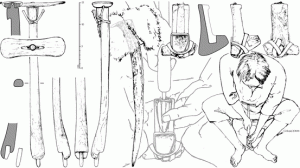Alaina Wilson, the speaker in the Villard room, talked about the similarities of Native American stoned tools from New York and Alaska. She compared different stoned tools and analyzed their use for the different regions. What really surprised me was that she never mentioned if the tools were made by indirect or direct percussion methods. In my opinion, this information would have been useful in determining what type of culture the knappers lived in. What also surprised me was the fact that the speaker only talked about technological similarities of the two societies.
In Pierre M. Desrosiers’s book, The Emergence of Pressure Blade Making: From Origin to Modern Experimentation, it’s evident that knapping techniques reveal information about preexisting cultures in Central Asia. Specifically, pressure knapping was present in Central Asia during the beginning of the Holocene. Desrosiers notes that depending on the culture, tools were either made using a short crutch or a long crutch. According to Desrosiers, Central Asian civilizations adopted the technique through cultural contact with the Far East and from migration of bearers of the technique from Siberia, Mongolia, Xinjiang. From this information, different methods of knapping can describe the influencing factors of cultures and can demonstrate how cultures evolve through technological advances. Thus I believe that knapping techniques can always describe technological and cultural traits of a society.
What I did learn from Alaina was that shock waves are sent through the stone during the process of knapping. Furthermore, Professor Lucy Johnson flint-knapping demonstration in class helped me visualize how flakes are produced. I noticed when the angle of contact was just slightly off, her stone would not form the way she wanted it to. Professor Johnson also enlightened the class that flake debris can help archaeologists reenact the knapping done and can indicate what type of tool was being made.
The analyzing of flake debris helped the archaeologist in the study compare the types of tools that were produced. After watching Professor Johnson knap and listening to Alaina, I was curious about the concept of flake debris sizes created from flint-knapping. I found out that there’s a relationship between the weight of crafted tools and the flake debris generated from knapping. According to archaeologist Michael Shott, flake debris can help determine original tool weight and can show the depletion of the original tool.
In all, Alaina Wilson’s hypothesis was proven by the discovery of similar weight distribution of the flakes from both sites, the fact that the stones went through feather termination, and the artifacts from both of the sites showed similarities in the late stages of the knapping process.
Photo Link:
http://link.springer.com/chapter/10.1007%2F978-1-4614-2003-3_18/fulltext.html
References:
http://www.jstor.org/stable/20177305?seq=16
Further Reading:
Short Crutch Demonstration (Pressure Knapping):
https://www.youtube.com/watch?v=SZMf4myJOVI (Flake removed at 3:00)

